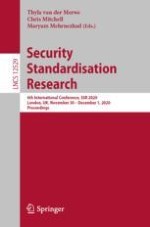2020 | OriginalPaper | Buchkapitel
Taming the Many EdDSAs
verfasst von : Konstantinos Chalkias, François Garillot, Valeria Nikolaenko
Erschienen in: Security Standardisation Research
Aktivieren Sie unsere intelligente Suche, um passende Fachinhalte oder Patente zu finden.
Wählen Sie Textabschnitte aus um mit Künstlicher Intelligenz passenden Patente zu finden. powered by
Markieren Sie Textabschnitte, um KI-gestützt weitere passende Inhalte zu finden. powered by
